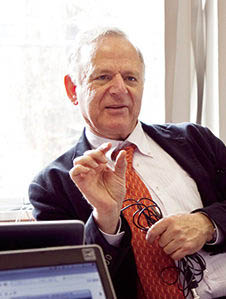Budapest Technical University, Department of Electrical Engineering,
Doctor of Engineering (Kyoto University)
ICME Society councilor, IEEE full member.
I can say with confidence from my experience at companies, research institutes, and at the university,
that the shortest way to enter the IT world is by “making things” with our own hands.
Here the “things” are not limited to physical devices, but also include software systems and services;
the important thing is, to make something that actually works and is useful to people.
It will, of course, require a variety of knowledge and skills to make things, but people who have
the drive to specific goals, rather than vague study, will make fast progress. It is always more
effective to search for knowledge that will be used to solve the issues needed to create something.
Another important point is that you’ll need to love these techniques. For example, my area of teaching
responsibility is programming, and if I were not liking it, I’m sure I would feel it a very boring
work. Having to remember countless conventions and rules, exposed to a severe world that do not
allow even one letter of mistakes, it would be nothing more than pain.
But for me, programming is also a hobby, and it is also a way to reach a power surpassing the “flesh
and blood” thinking ability of the human mind. For that reason, it becomes fun to learn a new programming
language, and fighting mistakes in a program (“bugs”) becomes a challenge like solving a puzzle.
The educational system at our graduate school is designed to support such learning. Students learn
a systematic knowledge in lectures and exercise courses, but they get the chance of such “making
things” in the “Special Theme Research” that leads to the master’s thesis. This is a very important
opportunity to be passed over, I sincerely recommended that you leverage it fully. Both the outcome
that you reach, and the road how you reached it, will become the treasure of a lifetime.
Programming, especially applied research on the development of embedded systems and human interfaces,
using Open Source Software (OSS). Recent research is focused on “Floating images” (systems using
a special optical element, which can project display screens in the air) and new interaction
methods using the system, as well as developing sensor technology and algorithms for this, to
be applied in areas such as in the visualization of medical information and for amusement.
Simulation, optimization, and linear motor technology, with the aim of revolutionizing the transportation
systems in buildings, by developing “multi-car elevators” (systems where multiple elevators
are running independently in the same hoistway) in collaboration with Sabanci University in
Turkey, and Cologne University of Applied Sciences in Germany.
While at Fujitec, developed and commercialized the world’s first learning type elevator group
control system using neural networks, and established the relevant optimization techniques and
simulation technology, securing a large number of patents. By helping the early introduction
of Open Source Software (OSS) to the company, contributed to improving the efficiency of research
and development. While doing research at the National Institute of Information and Communications
Technology, contributed to the development of the “floating touch screen” device and the floating
image optical element, obtaining further patents.


